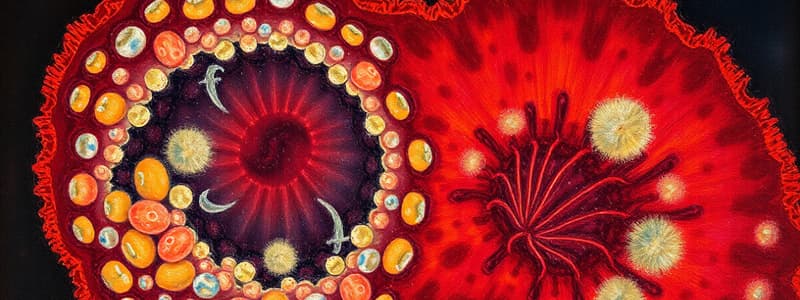Podcast
Questions and Answers
What primary function does the lysosome serve in a cell?
What primary function does the lysosome serve in a cell?
- Synthesize proteins and lipids
- Digest unwanted materials (correct)
- Regulate cell activities
- Store water and nutrients only
Which of the following best describes the role of the Golgi Bodies?
Which of the following best describes the role of the Golgi Bodies?
- Modify and package proteins (correct)
- Break down waste materials
- Store genetic material
- Produce ribosomes and RNA
What is the main function of ribosomes in the cell?
What is the main function of ribosomes in the cell?
- Translate genetic information to synthesize proteins (correct)
- Store genetic information
- Maintain cell structure through turgor pressure
- Synthesize lipids and detoxify
What distinguishes the smooth endoplasmic reticulum from the rough endoplasmic reticulum?
What distinguishes the smooth endoplasmic reticulum from the rough endoplasmic reticulum?
What is the primary function of vacuoles in plant cells?
What is the primary function of vacuoles in plant cells?
Flashcards
Cytoplasm
Cytoplasm
A jelly-like substance that surrounds and supports all the organelles within a cell. It's mainly composed of water, salts, and proteins.
Cell membrane
Cell membrane
The thin, flexible barrier that encloses the cell and controls what goes in and out. It's selectively permeable, allowing some substances to pass through while blocking others.
Mitochondrion
Mitochondrion
The powerhouse of the cell! It's responsible for producing energy (ATP) through cellular respiration.
Endoplasmic Reticulum (ER)
Endoplasmic Reticulum (ER)
Signup and view all the flashcards
Nucleus
Nucleus
Signup and view all the flashcards
Study Notes
Cellular Components
- Cytoplasm: A jelly-like substance surrounding organelles. It is composed of water, salts, and proteins. It holds organelles in place, suspending all organelles within.
Cell Membrane
- Cell Membrane: A thin, flexible barrier surrounding a cell. It controls what enters and exits the cell, acting as a semi-permeable membrane, selectively allowing certain substances in and out, such as water, proteins, and oxygen.
Cell Wall
- Cell Wall: A protective outer layer in plant cells, which regulates cellular activities like growth and metabolism. It contains DNA organized in chromosomes.
Nucleus
- Nucleolus: Located within the nucleus, it contains RNA and DNA and is responsible for producing ribosomes.
Endoplasmic Reticulum
- Endoplasmic Reticulum (ER): Two types:
- Rough ER: Synthesizes proteins by translating RNA instructions into functional proteins.
- Smooth ER: Lacks ribosomes, synthesizes lipids, plays a role in metabolism, detoxification, and hormone synthesis. Both types transport materials throughout the cell.
Ribosomes
- Ribosomes: Small structures composed of proteins, vital for translating genetic information (RNA) into chains of amino acids that fold into functional proteins.
- Free Ribosomes: Float freely in the cytoplasm.
- Bound Ribosomes: Attached to the endoplasmic reticulum (ER) to produce proteins for export or use within the cell membrane system
Golgi Bodies
- Golgi Bodies (Apparatus): Consist of sacs called cisternae. It modifies proteins synthesized by the ER by adding carbohydrates and phosphate groups, and packages them into vesicles for transport. It also transports lipids and modifies them, collects and removes material. Some Golgi bodies form lysosomes.
Chloroplasts
- Chloroplasts: Found in plant cells, responsible for photosynthesis. Chlorophyll gives chloroplasts their green color turning light energy into chemical energy.
Lysosomes
- Lysosomes: The cell's digestive system. Enzymes within lysosomes break down proteins, lipids, and carbohydrates, aiding in breaking down waste materials, bacteria or even the cell itself.
Mitochondria
- Mitochondria: The "powerhouse" of the cell. The site of cellular respiration, producing adenosine triphosphate (ATP), the cell's main energy source.
Vacuoles
- Vacuoles: Fluid-filled sacs. They store substances like water, nutrients, and even toxic waste products. Crucial for maintaining turgor pressure in plant cells, contributing to their structural integrity. Animal cells typically have smaller vacuoles.
DNA
- DNA: Contains the genetic instructions for growth, development, and function of the cell. It's the blueprint for all cell activities, and is replicated during cell division.
Centrioles
- Centrioles: Involved in cell division (mitosis) by organizing spindle fibers that move chromosomes.
Studying That Suits You
Use AI to generate personalized quizzes and flashcards to suit your learning preferences.




